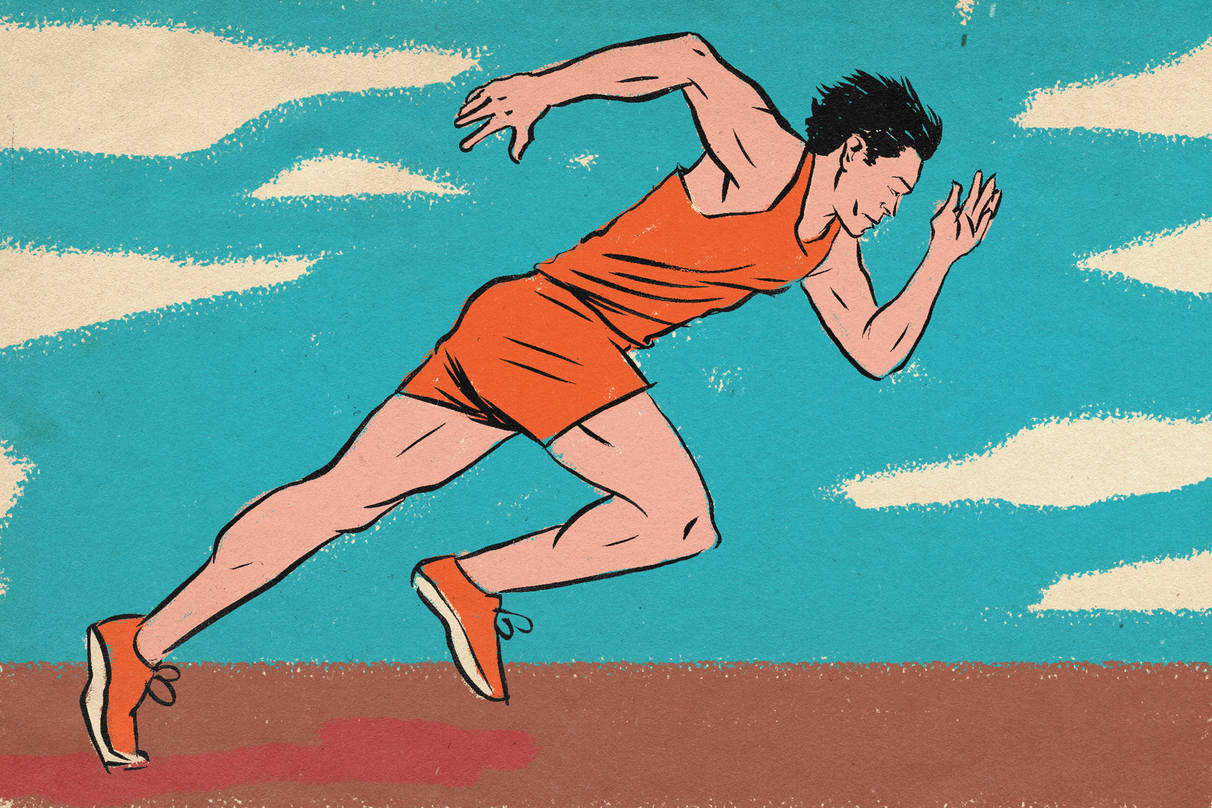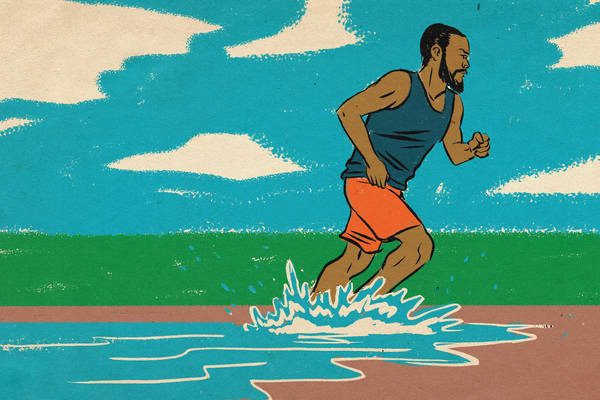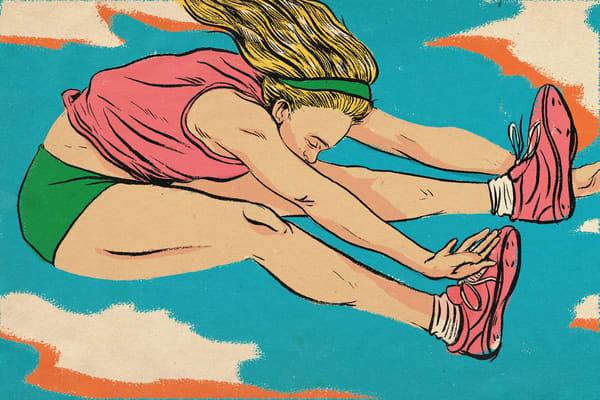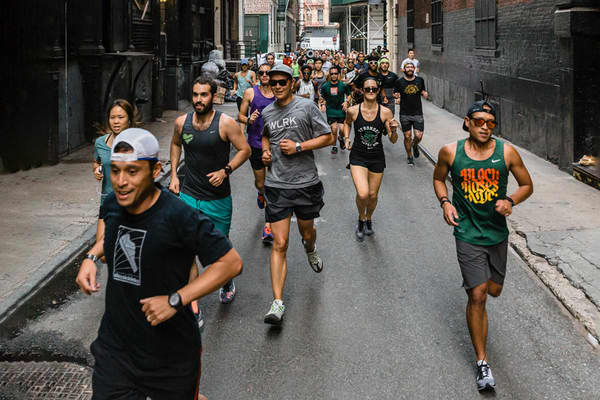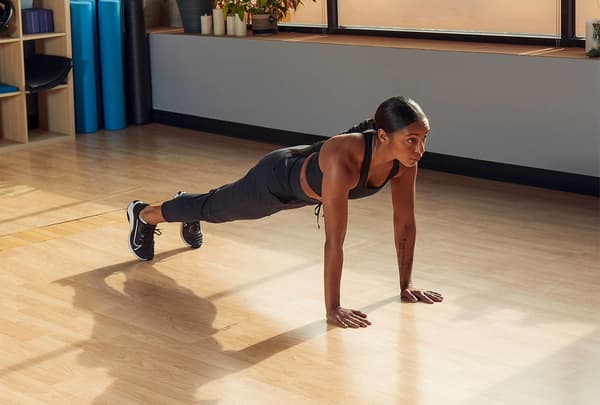A Beginner's Guide to All of the Events in Track and Field
Sports & Activity
With so many events — running, throwing, jumping, hurdling, race walking and more — track and field has something for everyone. Here’s a breakdown of the wide range of events in the sport.

If you’ve ever witnessed a track meet, you know there’s no shortage of action. Over the course of a single meet, there are dozens of contests taking place among all kinds of athletes: sprinters, jumpers, throwers, hurdlers, distance runners, race walkers and more.
The variety of races and competitions is one of the best things about track, said Steve Dolan, director of track and field and cross country at the University of Pennsylvania. With so many events, there’s bound to be one you enjoy, either as an athlete or a spectator.
Whether you’re looking for your next event to try or if you’re hoping to gain an understanding of the over 20 events featured at a track competition, check out this guide to learn from expert coaches in the sport, who explain what to know about the many disciplines in track and field.
But first, to follow along, it’s important to understand the track itself.
How Long Is a Lap Around the Track?
World Athletics, the international governing body for track and field, has set standards for competition tracks. One lap on the inside lane of a standard outdoor track is 400 meters. When there’s a 400-meter race, the runners go for one lap. A 200-meter race is half of a lap on the outdoor track.
Note: Standard indoor tracks are 200 meters long, so a 400-meter race on a standard indoor track would mean running two laps around the track.
When outdoor races are one lap or longer, you might hear an announcer refer to the “backstretch” and the “homestretch.” These refer to the two longer sections of the track, or straightaways. The “homestretch” is the straightaway where races finish, and the “backstretch” is the other straightaway on the opposite side of the track.
Almost all of the running and hurdling events at a track meet are held on the track. However, there are exceptions. At the Olympics, the marathon and certain race-walking events are typically held outside the stadium and finish on the track. At a standard middle school, high school, college or other professional outdoor track meet, the running events are held on the 400-meter oval.
The other events, like throwing and jumping, occur on the infield or another location near the track. These are the “field” events. From the track to the field, read on for an overview of each event below.
The Sprints: 60 Meters (Indoor Only), 100 Meters, 200 Meters, 400 Meters and 4x100-Meter and 4x400-Meter Relays
At the start of a sprint race, the runners in these events will have their feet in starting blocks — metal apparatuses that they use to explode off the line at the sound of the starter’s signal.
Sprinters are quick, of course, but to separate from the pack and become great, they need more than just raw speed, said Alton McKenzie, director of track and field and cross country at Georgetown University.
“In a short time, it gets very technical. When you get into the technicalities of trying to take a tenth of a second off your time, it takes a lot of work to do that,” he said.
Sprinters work on their starts, running form and techniques to shave fractions of a second from their times, which can make the difference between first and second place.
(Related: How to Get Faster at Sprinting, According to Experts)
While most of the sprints are individual events, there are also sprint relays. In these events, teams of four sprinters all run the same distance in sequence, passing a baton at each exchange between sprinters. In the 4x100-meter relay, for instance, the race is 400 meters total, with four runners each running 100 meters.
In an overlap zone that’s 20 meters long, each athlete passes the baton to the next runner, who then completes their 100 meters, and so on. In addition to the 4x100-meter relay race, there’s also a 4x400-meter sprint relay race.
If you’re in need of a new pair of kicks for sprinting, the Nike Maxfly 2 Blueprint — designed for the 100- to 400-meter events — is an optimal choice.
Middle-Distance Running Events: 800 Meters, 1,500 Meters, Mile, 4x800-Meter Relays
These races don’t start from blocks. Runners will often start in a lunge position, feet planted on the track. Athletes who compete in these middle distances need a combination of speed and endurance.
The 1,500 meters has been run at the Olympics since 1896 and is a standard distance at college and international competitions. Sometimes referred to as the “metric mile,” this distance covers three and three-quarters laps on a standard track. This distance is 109 meters shorter than a full mile.
At some competitions, athletes race the mile. A mile is 1,609 meters long — and four laps of a standard track equals 1,600 meters. Therefore, full mile races start a little more than 9 meters behind the finish line.
The 800 meters is sometimes referred to as the “half-mile,” even though it is not quite half a mile. At some — but not all — meets, there’s also a 4x800-meter relay race. Just like the sprint relays, four runners team up and each run the distance for a total of 3,200 meters in the race.
Long-Distance Running Events: 3000-Meter Steeplechase, 5,000 Meters and 10,000 Meters
These runs are endurance events. The 5,000 meters, or 5 kilometers, is 3.1 miles long. The 10,000 meters, or 10 kilometers, is 6.2 miles long.
In the 3,000-meter steeplechase, distance runners jump over large, hurdle-like barriers. On each lap of the race, as the athletes round the far curve of the oval track, they veer off to the inside of the track to jump over a water obstacle — a large barrier with a pool of water at the base.
After the runners clear the water obstacle, they return to the lanes of the oval as they continue racing. Over the 3,000-meter distance, steeplechasers run seven and a half laps around the track, tackling 28 barrier jumps and seven water jumps along the way.
Steeplechase barriers are different from the hurdles used in the hurdle races described below. In the men’s steeplechase event, according to the USA Track and Field (USATF) rule book, the barriers are 3 feet high, while women’s steeplechase barriers are 2.5 feet high. Both men’s and women’s steeplechase barriers are 3.96 meters wide.
Unlike hurdles that athletes jump over in sprint events, steeplechase barriers are fixed in place and won’t move if an athlete comes into contact with it. Since steeplechase barriers are thicker and sturdier than hurdles, runners can step on the top of the barrier to jump over it without knocking it down.
If you’re interested in checking out one of the fastest long-distance track spikes, try the Nike Dragonfly 2 Blueprints.
Race Walking: 20,000 Meters and 50,000 Meters
In race walking, athletes must always have at least one foot on the ground. If both feet come off the ground at the same time, the athletes would be considered running — not walking — and will be disqualified.
That doesn’t mean they’re moving slowly: The 2020 men’s Olympic champion in the 20K race walked at a pace of 14.8 kilometers per hour, or 9.19 miles per hour. That pace is about 6 minutes, 31 seconds per mile.
Race-walking events are not held at all meets — for example, the National Collegiate Athletic Association (NCAA) championships do not have race walks — and they may be held in different distances than listed here. But at the Olympic Games, race walking is held at distances of 20 kilometers (20,000 meters) and 50 kilometers (50,000 meters).
At the Olympics, both men and women race the 20K, while only men race the 50K.
Road-Running Events: Marathons and Half-Marathons
The marathon is 26.2 miles long. Therefore, the half marathon is 13.1 miles. While many marathon and half-marathon races are held on the roads, separate from track meets, the marathon is the last athletics event held at the Olympics, and both the half-marathon and marathon are run at the World Athletics Championships.
(Related: 9 Important Marathon Training Tips for New Runners)
Hurdling Events: 100-, 110- and 400-Meter Hurdles
In hurdle races, runners must jump over a series of 10 metal hurdles on their way to the finish line. According to the USATF rulebook, men’s hurdles are 1.067 meters high for the 110-meter hurdles and 0.914 meters high for the 400-meter race. Women’s hurdles are 0.84 meters high for the 100-meter hurdles and 0.762 meters high for the 400-meter distance.
The hurdles are spaced throughout these distances. In the 400-meter distance, hurdlers will run 45 meters to the first hurdle, then 35 meters between each subsequent hurdle. In the 100- and 110-meter distances, the hurdles are 8.5 and 9.14 meters apart, respectively.
In most meets, men run the 110-meter hurdles, while women run the 100-meter hurdles. Both men and women compete in the 400-meter hurdles.
Jumps: High Jump, Long Jump and Triple Jump
In the high jump, athletes run to jump off one foot and try to clear a 4-meter wide, thin, horizontal bar. If they hit the bar too hard, the bar will fall off its stand, and the jump doesn’t count.
Since the late 1960s, athletes have traditionally jumped backward over the bar, with their back facing the ground and their chests facing the sky. After their backward jump, athletes land on a big cushion called a crash pad.
In the long jump, athletes sprint along a 40-meter straightaway toward a takeoff board. When the jumper’s foot hits the take-off board, they jump as far as they can into a pit of sand. The number of jump attempts each jumper gets can vary from competition to competition, but in general, the longest jump wins.
For a jump to be legal, the jumper’s toe cannot pass the end of the takeoff board before they jump into the air. If the toe passes this line, it’s a foul, and the jump doesn’t count.
In the triple jump, athletes sprint up to a takeoff board before performing three consecutive horizontal jumps. These are referred to as a hop, step and jump. The hop is a one-footed jump where the athlete lands on the same foot they took off with, so if they hop with the right foot, they land on their right foot.
The next jump, or step, takes off from one foot but lands with the opposite. For example, a right-footed hopper will land on their left foot after the step. Finally, there’s the jump, where the athlete jumps from their landing “step” foot as far as they can into a sand pit.
Getting all those steps right takes a lot of coordination, said Dolan. It can be difficult to keep your momentum going while switching feet and trying to do all three moves smoothly.
But doing so is the key to success: The winning triple jumper is the athlete who has the furthest distance from the beginning of their “hop” to the end of their “jump.” As with the long jump, the number of jump attempts may be different in different competitions.
Though they specialize in jumping, athletes in all three of these events must be strong runners, McKenzie said. Since they need to sprint up to their take-off point, they spend more time running, both in training and in competing, than they do jumping.
Pole Vault
Just like in the high jump, pole vault athletes need to jump high in the air to clear a wide, horizontal bar without knocking the bar down. Just like high jumpers, pole vaulters land on a crash pad.
The difference, though, is the pole: Before jumping, pole vaulters sprint while carrying a long, flexible pole of fiberglass or carbon fiber. These poles can be as long as 5 meters.
The vaulter jams the pole into a box below the bar they’re trying to clear, and the pole bends. As it snaps back to straight, the pole flings the vaulter up in the air and — if they’re successful — over the bar. As with the high jump, the vaulter with the highest bar cleared is the winner.
Pole vaulters, Dolan said, must also be very coordinated to sprint fast, jam the pole in the right spot and stay in position for the maximum height to be achieved.
The Throws: Javelin, Shot Put, Hammer Throw and Discus
In all four of these events, athletes try to throw a piece of equipment as far as they can without stepping over a line or out of a circle. If they do, the throw is a foul and doesn’t count.
In the javelin, athletes throw a metal-tipped spear. The men’s javelin is 2.6 to 2.7 meters long and must weigh at least 800 grams (1.76 pounds). The women’s javelin is 2.2 to 2.3 meters long and must weight 600 grams (1.32 pounds) or more. Athletes run up toward a line and then throw the spear. If they step over the line, the throw doesn’t count.
Because the javelin throw is an overhead motion, baseball pitchers, quarterbacks and volleyball players — who perform a similar motion in their respective sports — often excel at javelin, said Nathan Ott, throws coach for Penn State University’s track and field team.
In the shot put, athletes throw a metal sphere called a “shot.” The men’s shot weighs 16 pounds, or 7.26 kilograms, while the women’s shot weighs 8.8 pounds, or 4 kilograms. The thrower usually holds the shot against their neck with one hand, then spins in a circle before throwing the shot as far as they can. Most athletes spin one and a half times before throwing.
The shot put circle has a diameter of 7 feet, or 2.135 meters, and has a board at the front of the circle, which athletes can brace against as they finish. But if their feet leave the circle, the throw doesn’t count. In most competitions, athletes throw six times. The athlete with the longest legal throw wins.
The hammer throw involves throwing from the same circle as the shot put, but the implement and the throw are much different. The “hammer” is a metal ball attached to a grip via a metal wire measuring 1.22 meters or shorter.
The metal ball at the end of the hammer weighs the same as the shot: The men’s hammer ball weighs 16 pounds, or 7.26 kilograms, while the women’s weighs 8.8 pounds, or 4 kilograms. Hammer throwers typically spin three or four times before releasing the ball and chain to let it fly across the field.
The last throw is the discus, where athletes fling a metal disc after one and a half spins in a slightly larger circle. The discus circle is 2.5 meters in diameter, compared to 2.135 meters for the shot put and hammer.
The men’s disc has a diameter of 22 centimeters and weighs 2 kilograms, or 4.4 pounds. The women’s disc has a diameter of 18 centimeters and a weight of 1 kilogram, or 2.2 pounds.
Combined Events: Decathlon, Heptathlon and Pentathlon
Each of these events is made up of multiple track and field events. Athletes in these combined events perform runs, jumps and throws during the meet, with each event scoring them a certain number of points. The points are totaled across all the events, and the athlete with the highest combined score wins.
The “deca” in decathlon is a prefix meaning 10, thus, the decathlon consists of 10 events: the 100-meter dash, long jump, shot put, high jump, 400-meter run, 110-meter hurdles, discus, pole vault, javelin and 1,500-meter run. This event is only staged in the men’s category.
In the women’s category, athletes who compete in combined events usually participate in the heptathlon, which has seven events (“hept” meaning seven). The events are the 100-meter hurdles, high jump, shot put, 200-meter run, long jump, javelin and 800-meter run.
Dolan said these combined events attract athletes who enjoy different sports or whose strengths are balanced — they may not specialize in any one event, but they’re skilled at many of them.
At some competitions when there is not enough time or space for a full heptathlon, a pentathlon — consisting of five events — is held instead. This is the case at the World Athletics Indoor Championships. The events in an indoor pentathlon are 60-meter hurdles, high jump, shot put, long jump and 800-meter run.
This is different from the modern pentathlon, which isn’t strictly track and field. This five-event combined competition, which is held at the Summer Olympics, includes a running event, but also includes disciplines outside of track and field — shooting, swimming, fencing and equestrian events.
At indoor meets, including the NCAA indoor championships, a men’s heptathlon is sometimes held. This event consists of a 60-meter run, long jump, shot put, high jump, 60-meter hurdles, pole vault and 1,000-meter run.
Words by Greg Presto










